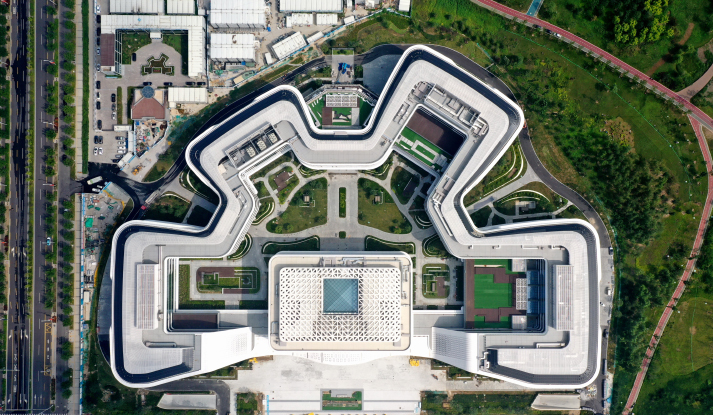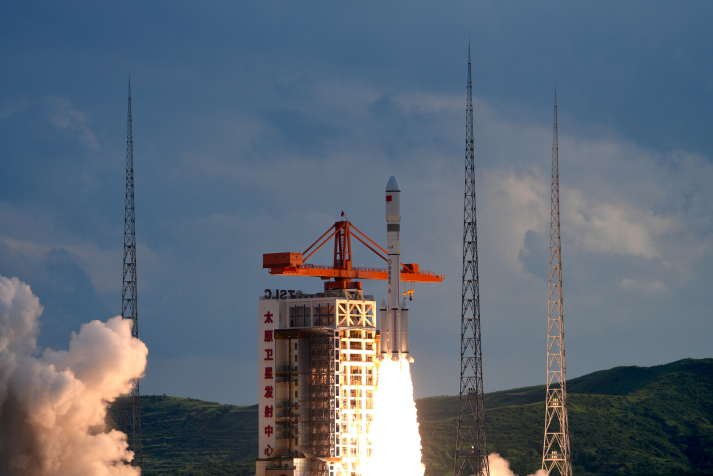| Voice |
| Tackling debris in orbit | |
|
|
|
Low Earth orbit satellite constellations are networks composed of satellites operating in near-Earth orbit—typically at altitudes ranging from 150 km to 2,000 km. These satellites are distributed across different orbital planes and work together to perform a variety of functions. Examples include U.S. SpaceX's Starlink project, China Satellite Network Group Co.'s GW Constellation project and Russia's Sfera program. As of July 2025, the Starlink system alone had nearly 8,000 satellites in orbit, with plans to deploy up to 42,000 in total.
 The headquarters of China Satellite Network Group Co. Ltd., operator of the GW Constellation project, in Xiongan New Area, Hebei Province, on March 19 (XINHUA)
However, such massive satellite systems also bring with them serious challenges in space debris management. Said debris refers to non-functional objects in space resulting from human activities, including defunct rocket stages and satellites, residual propellants, discarded mission components and fragments created by collisions between space objects. In other words, any human-made object in space that no longer serves a purpose is considered space debris. Currently, in-orbit debris has become a major concern for the sustainable use of space. Crisis in the cosmos According to analysis from the European Space Agency's (ESA) Space Debris Office, the increasing number of satellites in orbit is leading to an exponential rise in the risk of collisions. When the density of objects in low Earth orbit reaches a certain threshold, fragments generated from collisions can trigger a chain reaction, with orbital space becoming saturated with debris, in turn endangering future space operations. Defunct satellites and their fragments are key contributors to this risk. Currently, there are more than 34,000 pieces of trackable debris larger than 10 cm, and an estimated 900,000 smaller fragments ranging from 1 to 10 cm floating around in space. These tiny pieces are difficult to track and are considered the "invisible killers" of spacecraft in orbit. In November 2021, the Soviet-era Cosmos 1408 satellite was destroyed in a Russian anti-satellite weapon test, generating over 1,500 pieces of debris. In response, SpaceX had to perform around 1,700 collision avoidance maneuvers for its Starlink satellites. The sharp increase in space debris raises both the operational burden and risk for satellites in orbit. Frequent collision avoidance maneuvers consume propellant, thereby reducing the operational lifespan of satellites. Moreover, in densely populated constellations, repeated evasive actions can cause orbital disturbances and command conflicts between satellites. At present, the management of space debris faces two fundamental challenges. The first major issue is outdated and non-binding international regulations and frameworks. Existing international treaties such as the United Nations Guidelines for the Long-Term Sustainability of Outer Space Activities lack enforceability, particularly over private space actors. In July and October 2021, for instance, SpaceX satellites twice came dangerously close to China's Tiangong space station, prompting emergency evasive maneuvers by China. The lack of clear protocols on collision liability, compensation and post-incident resolution marks the urgent need for the international community to establish effective and enforceable space traffic management rules. The second challenge lies in the technical and economic barriers to active debris removal. Current approaches, such as ESA's ClearSpace robotic arm, laser ablation and Japan's ELSA-d space junk removal craft equipped with a magnetic capture system, remain in experimental stages and are yet to prove reliable in orbit. Additionally, the cost of removing a single large piece of debris can run into the tens of millions of U.S. dollars, or even over $100 million, making large-scale implementation economically daunting. Ready, set, action! In response to the global challenge of space debris, China has adopted a pragmatic and collaborative approach. Through the Asia-Pacific Space Cooperation Organization, China promotes regional cooperation in space debris monitoring and mitigation. Within the framework of the United Nations Committee on the Peaceful Uses of Outer Space, the Chinese Government has submitted multiple working papers on the long-term sustainability of outer space, advocating for the establishment of fair and reasonable international rules for space traffic management. On the technical front, China is enhancing its space debris monitoring and early warning capabilities. Tiangong is equipped with high-sensitivity monitoring instruments capable of continuously tracking debris larger than 10 cm in diameter. Additionally, China shares the data it collects with the Inter-Agency Space Debris Coordination Committee, contributing to the strengthening of global early warning systems. The Chinese Government has launched an effort to develop key space debris removal technologies, including capture and deorbiting, laying the groundwork for large-scale cleanup missions. China is also actively implementing debris mitigation standards. In 2023, the State Administration of Science, Technology and Industry for National Defense issued a notice on strengthening the administration of permits for civil space launch projects, which stipulates that "satellites or spacecraft must be deorbited once they reach the end of their designated lifespan as outlined in the license application materials."  A modified Long March-6 carrier rocket carrying a group of low Earth orbit satellites blasts off from the Taiyuan Satellite Launch Center in Shanxi Province on July 27 (XINHUA)
Up- and onward Addressing the growing crisis of space debris in low-Earth orbit requires collective action. The international community must actively promote negotiations on a code of conduct for space activities under the UN framework, with a particular focus on enhancing legal enforceability and implementation. Clear responsibility mechanisms must be established for space debris mitigation, removal and compensation. Breaking down technical barriers is equally essential. An international organization dedicated to collaborative research and development on space debris removal technologies should be established to share experimental data, distribute development costs and secure long-term mutual benefits. Exploring viable models for commercial space debris removal services can help resolve the structural contradiction between high economic costs and the need for large-scale cleanup. At the same time, global space surveillance resources should be integrated to develop an open, transparent and cooperative platform, providing accurate support for collision warnings and traffic management. Furthermore, the development of in-orbit servicing and satellite life-extension solutions is essential to reducing the number of inactive satellites and improving sustainability. China's 2022 white paper, China's Space Program: A 2021 Perspective, emphasizes that China adheres to the principles of innovation-driven, coordinated, efficient and peaceful progress based on cooperation and sharing to ensure a high-quality space industry. Only by abandoning zero-sum thinking and embracing the vision of a community with a shared future for humanity can we preserve space as a safe, accessible domain for future generations. Space debris management is not only a technological battle—it is the ultimate test of our collective wisdom and global collaboration. Xiao Junyong is executive director of the Research Center of Science and Technology and Human Rights, Beijing Institute of Technology; Li Dinggen is an assistant research fellow at the center Copyedited by Elsbeth van Paridon Comments to dingying@cicgamericas.com |
|
||||||||||||||||||||||||||||||
|